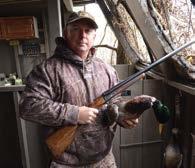














































































I cannot wait for this year to be over. This has been a tough year for me, both professionally and personally, and I’m looking for brighter and better days in 2023.
The year started o with the loss of a couple of key employees, one to retirement, and the other to another job. Even this magazine had its share of problems, to the point that some months I was not certain we would be able to get it published.
We have had to deal with paper shortages (apparently a strike in Finland helped cripple the world’s paper supply), skyrocketing paper prices, and then our printer canceled our contract with little notice. (Something about being too big for their business model.)
For
My wife had a much-needed knee replacement, which left me as a “care giver,” not exactly my strong suit. Oh, and for those of you who think your children will be helpful — ours fled the house like rats from a sinking ship. (I have been in contact with my attorney, and we are making some changes in the will.)
If you ever find yourself with a strong desire to take a pillow and smother the one that you love, take a deep breath, and make a Krystal run. I promise you will feel much better.
ahead.
This year’s runaway inflation has wreaked havoc on our operating budget, much like it has done to just about every business in the country. Luckily, I have a great sta and they worked hard to help us navigate these many hiccups in 2022. Some stepped up to take promotions, while others added to their job duties until we could get new personnel in place. I am proud of them and the job they do. After this year, I have no doubt that I have the best cooperative statewide sta in the country. Personally, the year started o with a hospital stay and two stents for my heart. I now have a diet that basically is, “if it tastes good, spit it out.” I must confess, I cheat. Between my wife and my administrative assistant, I feel like I am under 24-hour surveillance. I found myself slipping out the back door of my o ce and making a stealth run to a nearby Krystal. After that, I would drive to Ridgeland City Park and eat the small burgers in solitude before disposing of the evidence in a park trash can. It was exhilarating to be living so dangerously. I have also dealt with the loss of some close family members, including my father. My mom recently moved in with us, after a long hospital stay, and we are working to rebuild her strength so that she can return home soon.
The year did have some bright spots, especially during the month of May. My two oldest children, Michael and Katlyne, both graduated from The University of Southern Mississippi. I shot my lowest score for 18 holes of golf. Melissa and I celebrated our 33rd wedding anniversary.
Everyone has problems. Some of you have had a bad 2022, some of you, after really thinking about it, realize maybe it wasn’t as bad as you thought. I have always believed that whatever problems I have, they pale in comparison to the problems of others. I am blessed, even though sometimes, I forget that I am.
As the year ends and we celebrate Christmas, let us remember that with Christmas comes hope. It’s not just about food, fellowship, and presents. For Christians, Christmas should remind us that God sent us a savior, not to just give us hope for this life, but hope for what lies ahead. Yes, we will encounter tough times, but we do not have to endure them alone. He will be with us.
So, I hope everyone has a Merry Christmas and a much better 2023!
by Michael Callahan Executive Vice President/CEO Electric Cooperatives of Mississippi

Sitting in a tree stand up in a tall White Oak, that whitetail buck deer tipping through the slough so slow.
The pop of a jug when that blue cat takes the bait, being out on the Tenn-Tom River at night, real late.
A plump fox squirrel sitting high up in a Pine, flicking her tail as the cur dog tries to find her before she can hide.
Ole Tom turkey gobbling across the creek, hiding in a brush top hoping he struts by me.
Throwing a frog across the lily pads and grass, setting the hook on a 5-pound bass.
Being in the woods as the morning sun shines bright, or on the riverbanks, the moon my only light.

Way out yonder with all of God’s Dixieland delights.
by Tia Greene, a resident of Columbia, and a member of 4-County Electric.

What’s Mississippi to you? What do you treasure most about life in our state? Send your brief thoughts to Today in Mississippi, news@ecm.coop or mail to P.O. Box 3300, Ridgeland, MS 39158
Submit your beautiful digital photo of life in Mississippi to Today in Mississippi, news@ecm.coop

Christians, Christmas should remind us that God sent us a savior, not to just give us hope for this life, but hope for what lies
Yes, we will encounter tough times, but we do not have to endure them alone. He will be with us.A Walker hound treeing in the river bottom, his long bawl bark telling me he’s got ‘em.
The Official Publication of the Electric Cooperatives of Mississippi
Vol. 75 No. 12
OFFICERS
Randy Carroll - President
Ron Barnes - First Vice President
Tim Perkins - Second Vice President
Brian Hughey - Secretary/Treasurer
Michael Callahan - Executive Vice President/CEO
EDITORIAL STAFF
Lydia Walters - VP, Communications
Steven Ward - Editor
Chad Calcote - Creative Director/ Manager
Kevin Wood - Graphic Designer
Alan Burnitt - Graphic Designer
Courtney Warren - Graphic Designer
Chris Alexander - Member Services Coordinator
Steve Temple - Social Media Director
Mickey Jones - Administrative Assistant

EDITORIAL OFFICE & ADVERTISING
601-605-8600

Acceptance of advertising by Today in Mississippi does not imply endorsement of the advertised product or services by the publisher or Mississippi’s electric power associations. Product satisfaction and delivery responsibility lie solely with the advertiser.
• National advertising representative: American MainStreet Publications, 800-626-1181
Circulation of this issue: 469,163

Non-member subscription price: $9.50 per year.
Today in Mississippi (ISSN 1052-2433) is published 12 times a year by Electric Cooperatives of Mississippi Inc., P.O. Box 3300, Ridgeland, MS 39158-3300, or 665 Highland Colony Parkway, Ridgeland, MS 39157. Phone 601-605-8600. Periodical postage paid at Ridgeland, MS, and additional office. The publisher (and/or its agent) reserves the right to refuse or edit all advertising.
POSTMASTER: Send all UAA to CFS. (See DMM 507.1.5.2)
NON-POSTAL AND MILITARY FACILITIES: send address corrections to: Today in Mississippi, P.O. Box 3300, Ridgeland, MS 39158-3300 www.facebook.com/TodayinMississippi

Rolls-Royce — powered by Singing River Electric — has completed a major investment in its Pascagoula site that will provide increased capabilities and capacity to support U.S. Navy programs.
A new 26,000-foot facility, with foundry and machining equipment provided by a U.S. Department of Defense DPA Title III grant, will increase the company’s ability to manufacture propellers and propulsor components for naval platforms.

Dan Rediger, Rolls-Royce Head of Naval Operations – Defense said: “We’re excited to complete a second major U.S. investment in our naval capabilities since 2020, with the opening of this new facility in Pascagoula, Mississippi. Rolls-Royce is proud to play a vital role in the shipbuilding supply chain and we remain committed to supporting the growing needs of the U.S. Navy with world-class, American-made products and services.”
Some of the first work to be delivered from the new facility will be fixed-pitch propellers for the U.S. Navy’s Constellation-class (FFG-62) guided missile frigate program. Last year, Rolls-Royce reached agreement with Fincantieri Marinette Marine to design and manufacture up to 40 propellers for the program.

Poultry farmers, state legislators, local government o cials, loggers, fuel retailers, energy utilities and utility regulators were all represented at an October roundtable to discuss the impact of high energy prices on farmers and businesses. Organized by national organization, the Consumer Energy Alliance (CEA), the purpose of the discussion was to learn about challenges in specific business sectors and to raise awareness about the linkage between high energy costs, access to energy, and energy policy at the state and federal levels.
Even though electric cooperatives have been hiring more ex-military, the energy sector still tends to fly under the radar for veterans.
The irony of this “awareness gap” is that there is near-universal agreement about the synergies between military service and the electric industry.
“Both have strong people with a sense of loyalty and duty in serving our community or country,” says National Rural Electric Cooperative Association Principal for Cybersecurity Ryan Newlon, who spent 20 years in the Missouri Army National Guard. “It blows my mind that they’re so similar.”
Over the past two years, there’s been a wave of veteran retirements from the energy industry, dropping their representation from 9.6% in 2019 to 8% in 2021, according to the latest Gaps in the Energy Careers report published by the Center for Energy Workforce Development.
Raising the energy industry’s profile among vets is especially critical at electric co-ops, where the pending retirement rate is particularly high, with some 35% of co-op employees expected to leave within the next six to 10
years, according to CEWD data.
NRECA Workforce Programs Manager Desiree Dunham says it’s essential that co-ops are seen as a viable option for all potential talent pipelines.
“Connecting with men and women transitioning out of the military and showing them the career options and how ideal a fit co-op work is will help coops with building a skilled and diverse workforce,” she says.
NRECA launched its Vets Power Us initiative, which Dunham leads, in 2020 to facilitate the connection between job-seeking veterans and co-op career opportunities. Co-ops can access resources to help recruitment e orts and provide information to veterans about jobs.







There are similar hiring initiatives throughout the energy industry, but veterans nevertheless are proving an elusive group to attract.



Advocates say it boils down to breaking down barriers, meeting the veterans where they are, creating awareness of energy jobs, and highlighting the similarities.
— Victoria A. Rocha. RE Magazine
Congressman Michael Guest led the discussion and listened to participants, like poultry farmers, who talked about how 70% energy cost increases have wiped out profits and added uncertainty to the future of their business.
“The rising cost of energy is leading to higher prices for everything — impacting families across our state as they struggle to purchase gas and groceries,” Guest said. “To combat these high costs, I am fighting for strong domestic energy policies through my work in Congress. I’m grateful for the opportunity to work with the Consumer Energy Alliance, the Mississippi Energy Institute, and other experts on these issues toward our common goal of bringing down energy costs and securing our nation’s energy independence.”
Some of the discussion was around federal energy policies advanced by the current administration that have resulted in less investment and growth in American oil and gas production during the postpandemic period.
As other places are dismantling their economies due to restrictive energy policies, Mississippi and other energy producing states should sell themselves as reliable energy states and raise awareness about the policies that result in abundant energy at a more a ordable cost.












My wife, Katie, and I recently traveled in Florida after I was a keynote speaker for the Florida Master Gardener Volunteer Conference. We enjoyed collecting seashells on Cocoa Beach while watching the latest SpaceX launch. As children of the 60s who grew up watching the exploits of NASA, this was really cool!
We made our way to New Port Richey — the locals call it NPR — just north of Tampa on Florida’s west coast. It was our first visit there, and we stayed at a historic hotel called The Hacienda, built in 1927. It is on the Registry of Historic Places and has a colorful history.
New Port Richey was known as Hollywood East during the 1920s. The story goes that The Hacienda was built at the request of silent movie star Gloria Swanson, who wanted a place where all her celebrity guests could stay.
It’s even been named by Thrillist as the most haunted hotel in the state of Florida. We didn’t see any ghosts, but one night, I’m sure I heard an ethereal voice in the hallway say, “Miss Swanson, you look marvelous.”
The thing that is striking about The Hacienda is the color of the hotel, which is a brilliant, bright shell pink.








This brings me to a beautiful plant — pink muhly grass. The hotel has fantastic plantings of muhly grass with its billowy, cloud-like masses of pink flowers.
Gulf Muhly grass is a Southeast native plant that really struts its stu in fall and winter months. Also known by its botanical name, Muhlenbergia capilaris, Muhly grass was chosen as a Mississippi Medallion native plant winner in 2010.
Its unique texture with spiky, upright leaves brings summer interest. But it’s the plant’s last grand flourish that really creates landscape excitement. As long as there isn’t a hard freeze, the color will hold. Even after freezing temperatures, the flower heads keep their airy shape.

There is even a selection with billowing, white flower masses called White Cloud. My social media accounts have been sharing a lot of great-looking images of White Cloud this month.
Consider spacing needs. While a mass planting of Gulf muhly grass is gorgeous, these plants need their individual space to achieve that filled-in mass look.

As with all ornamental grasses, there is only one maintenance task that can’t be neglected. In late winter, cut the grass clumps back to 6 inches before spring growth starts. This cutting clears the way for new foliage and results in a nicely formed clump. Don’t be tempted to cut back any earlier because you will remove the dry inflorescences that create movement with the wind and habitat for wildlife.
Now is a great time to plant this native species, and the independent garden centers I’ve been visiting have an abundant inventory of great plants to take home with you.
Beyond the cypress trees slowly converting this ancient river channel into a swamp, distinctive quacking reverberated through the shrouding fog as the sky began to brighten on this chilly Mississippi Delta dawn.











Inside the blind overlooking an opening in the swamp, hunters tensed for action with guns at ready as they peered through shooting holes. Quacking grew louder as we tracked the progress of the birds. Finally, about 20 colorful mallards burst through the fog over the decoys.

Eons ago, the unpredictable Mississippi River spasmodically changed course, leaving behind numerous former parts of its own channel as oxbow lakes. Now, Beaver Dam Lake sits eight miles east of the main channel south of Tunica. Since Beaver Dam Lake no longer connects to the river, sportsmen can only access it through private property.
Beaver Dam Lake sits squarely in the Mississippi River Alluvial Valley of the Mississippi Delta, one of the most critical wintering waterfowl habitats in North America. The Delta runs about 200 miles along the eastern bank of the Mississippi River and spreads across nearly 7,000-square-miles covering all or part of 19 Magnolia State counties.
“The Mississippi River is a big interstate for migrating ducks,” explained Mike Boyd with Beaver Dam Hunting Services. “Ducks have been coming here for eons. Beaver Dam Lake has been a good duck hunting spot for a long time and it’s still good. It’s one of the few places that I’ve ever seen where people can kill ducks every morning out of the same blind. When a cold front comes through, we get many birds migrating through the area.”
One of the best known and most beloved outdoor writers of his time, Theophilus Nash Buckingham, (1880-1971), enthralled generations with his hunting tales. Nash hunted many places and wrote about them, but none probably mattered more to him than his beloved Beaver Dam Lake.











“God made Beaver Dam Lake, but Nash Buckingham made it famous,” Boyd quipped.

Nash’s father helped found the Beaver Dam Ducking Club in 1882, so Nash grew up hunting the swampy, 1,500-acre oxbow. In the 19th century, sportsmen rode steamboats down the river from Memphis, later trains, to hunt the Mississippi River oxbows.
Beaver Dam Hunting Services operates blinds placed in cypress brakes at the south end of the lake. One blind sits on a pothole dubbed “The Cloverleaf Hole,” so named by “De Shootinest Gent’man” (Buckingham) himself!
“Nash hunted this area quite a bit in his early years,” Boyd said. “Later, he frequently hunted the lake with Horace Miller. The original Beaver Dam Ducking Club clubhouse was destroyed in a storm years ago, but Miller’s old house still stands. Nash brought the life and vernacular of that day alive.”
Do-it-yourselfers can find many public places to hunt throughout the Delta. The Sunflower River flows through Sunflower Wildlife Management Area (WMA), part of the Delta National Forest, about 10 miles east of Rolling Fork. Not far from Sunflower WMA, Howard Miller WMA o ers good duck action. Waterfowlers can also hunt the Mahannah and Muscadine Farms WMAs.
by John N. FelsherBeaver Dam Lake has been a good duck hunting spot for a long time and it’s still good. It’s one of the few places that I’ve ever seen where people can kill ducks every morning out of the same blind.John N. Felsher is a professional freelance writer, broadcaster, photographer, and editor who lives in Alabama. An avid sportsman, he’s written more than 3,300 articles for more than 170 different magazines on a wide variety of outdoors topics. Contact him at j.felsher@hotmail.com.




























Live oak trees can live a long time.
Friendship Oak, the giant, sprawling tree on the front lawn of The University of Southern Mississippi’s Gulf Coast campus in Long Beach, has been around for more than 500 years.
No hurricane, including Katrina in 2005, has been able to knock it down during all that time.
If future hurricanes don’t tear it apart and people don’t treat the tree and area around it recklessly, Friendship Oak could survive another century, said Blake Bailey, a Mississippi State University Extension Service forester.
“Live oak trees live a longtime, but Friendship Oak is an exceptionally old tree,” Bailey said.




Measurements taken in 2011 show the tree with a height of 59-feet; diameter of the trunk at 5 feet, 9 inches; a circumference of the trunk at 19 feet, 9 ½ inches; and a foliage spread of 155 feet, according to USM o cials.
The average length of the main lateral limbs is 60 to 66 feet from the trunk. The average limb circumference at the trunk is 7 ½ feet, while the tree forms almost 16,000 feet of shelter; and the lateral roots go out 150 feet.
Friendship Oak turns up on all the tourism websites as a place to visit. I drive past the tree on my way to work, and I can’t tell you all the times I’ve seen cars with license plates from other states stopped, and people taking photos.
“Most trees are taller than they are wide. Live oaks are the opposite and are twice as wide as tall. Live oaks have the densest, hardest wood of any Mississippi tree,” Bailey said.
Allisa Beck, a USM librarian at the Gulf Coast campus who has worked at the university since 1983, said the tree was the center of campus activity in between 1921 and 1971 — when the school was the Gulf Park College for Women. USM took over in 1972.
“Whenever there was a hurricane or storm, we would get calls from the women who graduated from Gulf Park College asking us if the tree was OK,” Beck said.
The area around the tree has been utilized for years for events, weddings, high school prom photos, graduation activities, and general sightseeing.
“Friendship Oak turns up on all the tourism websites as a place to visit. I drive past the tree on my way to work, and I can’t tell you all the times I’ve seen cars with license plates from other states stopped, and people taking photos,” Beck said.

Beck said there is a chain around the tree to discourage people from climbing or getting too close. Before Hurricane Katrina, the tree had a platform/stairway around the tree that resembled a tree house. The storm destroyed the platform, and it wasn’t rebuilt.
In August 2017, one of the main limbs on Friendship Oak broke due to the weight of new growth and heavy rain. The tree’s health was subsequently assessed by a certified arborist, and the failed limb was removed in October 2017. Remediation work included some pruning plus installation of bracing to support other limbs, USM o cials said.
Bailey called Friendship Oak one of the most beautiful trees in Mississippi.
“I’m a tree guy, so I feel very moved when I’m around these big, old trees. So, yeah, I feel that way about Friendship Oak. All the live oaks on the Gulf Coast make the place so special,” Bailey said.
If live oak trees are your thing, you can take a ride to nearby Ocean Springs to visit Twelve Oaks Nature Trail.
A short half-mile loop trail winds through the remnants of a garden, diverse bayhead swamps, and provides a scenic vista of Old Fort Bayou.

1112 Hanley Road
Ocean Springs
Details: 228-435-9191
After turning north onto Hanley Road from Bienville Boulevard, turn left onto the gravel driveway where the paved road ends. Park outside the gate and walk in.
Source: Land Trust for the Mississippi Coastal Plain















Like millions of older Americans, I struggle with mobility. For years, I watched my quality of life slip away, as I was forced to stay home while friends and family took part in activities I’d once enjoyed. I thought I’d made some progress when I got a mobility scooter, but then I realized how hard it was to transport. Taking it apart and putting it back together was like doing a jigsaw puzzle. Once I had it disassembled, I had to try to put all of the pieces in the trunk of a car, go to wherever I was going, and repeat the process in reverse. Travel scooters were easier to transport, but they were uncomfortable and scary to drive, I always felt like I was ready to tip over. Then I found the So LiteTM Scooter. Now there’s nothing that can hold me back.












Years of work by innovative engineers have resulted in a scooter that’s designed with seniors in mind. They created Electronic Stability Control (ESC) that makes it virtually impossible to tip over. If you try to turn too quickly, the scooter automatically slows down to prevent it from tipping over. The battery provides powerful energy at a fraction of the weight of most batteries. With its rugged yet lightweight aluminum frame, the So LiteTM Scooter is the most portable scooter ever—but it can hold up to 275 pounds—yet weighs only 40.8 pounds without the battery! What’s more, it easily folds up for storage in a car seat, trunk or even on an airplane. It folds in seconds without tools and is safe and reliable. Best of all, it’s designed with your safety in mind, from the newest technology and superior craftsmanship. Why spend another day letting your lack of mobility ruin your quality of life? Call now and find out how you can get a So LiteTM Scooter of your very own.




For more information, call 601-947-4211 or 228-497-1313. SRE is an equal opportunity employer and provider.


To say 2022 has been challenging would be an understatement. Similar to what you have experienced at your homes over the past year, Singing River Electric has seen significant cost increases associated with materials, equipment, contract labor, and fuel. Scarce materials and high demand are part of a 40-year inflation high according to the Federal Reserve Bank, resulting in increased costs of business. For example, the price of a pole mount transformer used to provide electric service to a member home more than doubled over the past two years. The cost of a conductor for a threephase distribution line went up more than $15,000 per mile of line. In addition to inflated material costs, increased fuel prices have led to higher freight costs, higher contractor expenses, and additional costs for Singing River Electric employees to build and maintain our electric distribution system.

The rise in costs, combined with the existing supply chain issues, created an even greater challenge for your cooperative. Ramifications of the COVID-19 pandemic continued to cripple the nation’s supply chain system, decreasing the supply of raw materials and finished goods at a time when demand remained steady or even grew. To combat
the situation, Singing River Electric took a proactive approach to navigating the supply chain system by increasing the levels of items with longer lead times and placing orders well in advance for future projects. Singing River Electric’s strong relationships with suppliers have been a key advantage while procuring items necessary for providing reliable electric service to members. We are told supply chain disruptions may be here for a while longer. In the meantime, Singing River Electric will remain proactive in procuring materials, using creative decision making, maintaining vendor relationships, and praying Mother Nature is kind to us.
As a result of these challenges, Singing River Electric began a cost-of-service study last month to guide your cooperative in making sure funds are available so we can continue providing the safest and most reliable service to our members. We will obtain and review the results in the coming weeks.


Even with the many challenges experienced this past year, our employees continue to step up and provide the level of service our membership has come to expect. On behalf of the Singing River Electric family, I wish you a blessed Merry Christmas and a Happy New Year.
This holiday season, consider replacing older light strings with new Energy Star LED lights. They use 75 percent less energy than traditional incandescents and come in a variety of styles and colors for both inside and outside use. In fact, the energy used to light just one incandescent bulb can power two 24-foot strings of LED lights.

You can save even further by installing a timer for outdoor holiday lighting and decorations. Program the timer to turn on in the evenings and to turn o when you go to bed.
There’s also the safety benefit. Energy Star decorative LED holiday lighting is cool to the touch, which reduces the risk of fire.
For more information, visit singingriver.com and energystar.gov. Happy Holidays.
Merry, bright, and e cient holiday lightingGeneral Manager and CEO Brian Hughey





















and block harmful apps, websites












Call us today at 877-272-6611 to add the Ultimate Wi-Fi Experience bundle.







SR Connect is delivering lightning-fast, fiber internet. Our most recent fiber opening is in SRE’s Harleston substation area. Call 877-272-6611 to sign up! Scan the QR code to search your address and view full-size maps of all fiber areas.
Visit singingriverconnect.com/signup to view full size maps.













Don’t like to wait on hold? Neither do we. Text a Singing River Electric member service representative (MSR) at 228591-9166. We will return your text and help resolve your issue or answer your inquiry. You can also text OUT to 601-947-1744 to report a power outage.






As of November 2022, SRE members were automatically enrolled in outage texting with


the cell phone number listed on their account. Members must have a mobile number on file to use outage texting because the system locates their account information with the number. Phone numbers and other contact information can be updated using the SmartHub mobile app, by texting a MSR, or by calling 601-947-4211 or any SRE o ce.
Our o ces will be closed Dec. 23 and 26 in honor of the Christmas holidays and Jan. 2 for the New Year’s holiday. Dispatchers will be on duty for emergencies and power outages. Use your SmartHub app to see billing information, make payments and see a live outage map.
singingriver.com/ SmartHub



SRE’s board of directors approved the retirement of more than $2 million in SRE capital credits to the membership for the year 1996. Cooperative Energy also retired $1.5 million in credits to SRE members for the year 1992 and partial returns for the years 2007, 2008 and 2009.
Capital credits less than $300 will be credited on December member bills. Credits greater than $300 will be mailed to SRE active members as a check. Visit singingriver.com/capital-credits for additional information.

and
Neighbors Helping Neighbors (NHN) Community Grants help Singing River Electric merge e orts with the hard work of those within our communities.
Since the program’s inception in 2001, $333,842.12 has been awarded to local non-profits in local communities.
George County School District resource o cers have needed gear and equipment after receiving a $2,500 Singing River Electric Neighbors Helping Neighbors Community Grant.

Funds from the grant purchased laptop computers, reflective vests, handcu s, firearm holsters, and other items for the three newly hired district resource o cers. The school district serves more than 4,100 students at eight schools and has a goal of providing quality education in a safe and secure atmosphere.
“We are grateful for the Singing River Electric grant program. It’s allowed us to provide our o cers the tools needed to protect not only our students and sta but also our community,” said Caleb Davis, Chief of the George County School District Police Department.
For more information on SRE NHN Community Grants and how to apply, visit singingriver.com/my-community. Grants for up to $2,500 are awarded to nonprofits in SRE’s service area three times a year in January, May, and September.
Round up your electric bill and help a neighbor in need this holiday season and year round. It’s easy! Simply check the NHN Energy Assistance box on your bill payment stub, sign up using the SmartHub app on any mobile device, go online and visit singingriver.com/give-joy or call any SRE o ce and request to be enrolled in Neighbors Helping Neighbors Energy Assistance giving.
Donations average only $6 per year and yet bridge the gap for the elderly and those needing a helping hand.
It was a perfect late autumn day in the northern Rockies. Not a cloud in the sky, and just enough cool in the air to stir up nostalgic memories of my trip into the backwoods. is year, though, was di erent. I was going it solo. My two buddies, pleading work responsibilities, backed out at the last minute. So, armed with my trusty knife, I set out for adventure.
Well, what I found was a whole lot of trouble. As in 8 feet and 800-pounds of trouble in the form of a grizzly bear. Seems this grumpy fella was out looking for some adventure too. Mr. Grizzly saw me, stood up to his entire 8 feet of ferocity and let out a roar that made my blood turn to ice and my hair stand up. Unsnapping my leather sheath, I felt for my hefty, trusty knife and felt emboldened. I then showed the massive grizzly over 6 inches of 420 surgical grade stainless steel, raised my hands and yelled, “Whoa bear! Whoa bear!” I must have made my point, as he gave me an almost admiring grunt before turning tail and heading back into the woods.


But we don’t stop there. While supplies last, we’ll include a pair of $99 8x21 power compact binoculars FREE when you purchase the Grizzly Hunting Knife. Make sure to act quickly. The Grizzly Hunting Knife has been such a hit that we’re having trouble keeping it in stock. Our first release of more than 1,200 SOLD OUT in TWO DAYS! After months of waiting on our artisans, we've finally gotten some knives back in stock. Only 1,337 are available at this price, and half of them have already sold! Knife Speci cations:
• Stick tang 420 surgical stainless steel blade; 7 ¼" blade; 12" overall • Hand carved natural brown and yellow bone handle • Brass hand guard, spacers and end cap • FREE genuine tooled leather sheath included (a $49 value!)

I was pretty shaken, but otherwise ne. Once the adrenaline high subsided, I decided I had some work to do back home too. at was more than enough adventure for one day.
Our Grizzly Hunting Knife pays tribute to the call of the wild. Featuring stick-tang construction, you can feel con dent in the strength and durability of this knife. And the hand carved, natural bone handle ensures you won’t lose your grip even in the most dire of circumstances. I also made certain to give it a great price. After all, you should be able to get your point across without getting stuck with a high price.


































































 by Jim Beaugez
by Jim Beaugez
The choir, one of the state’s great musical groups, records its 11th album in 34 years.
ackstage at Word of Life Church in Flowood on an early autumn evening, veteran music executive, songwriter, and producer Jerry Mannery is everywhere at once, taking care of last-minute preparations and greeting well wishers.
In less than half an hour, he’ll take the stage for the Mississippi Mass Choir’s first recording in nearly a decade.

Despite the anticipation growing among the audience on the other side of the stage door, Mannery is cool and focused — and he has every reason to be. As executive director of the revered Mississippi Mass Choir, he leads one of the most seasoned and celebrated gospel groups in the world. And he’s been around for all 34 years of the group’s ride to Grammynominated, globe-trotting success.
Tonight’s occasion isn’t about any of those accolades or accomplishments, though. Gathered before a sold-out audience, the 220-member choir is recording the performance for their 11th album, tentatively titled We Still Believe!, set for release in spring 2023 via the Jackson-based Malaco Music Group, the choir’s home since the beginning.
“We still believe there’s a place for choirs in the gospel music industry,” Mannery says, as he meanders through the corridors behind the chancel ahead of showtime. “We still believe there’s a place for choirs in the church. We still believe that God is God, and we still believe He fulfills all His promises.”
That last point — a belief in God’s promises — will show up in at least two of the songs in the night’s set. All the songs were written specially for this performance, which was originally scheduled preCovid, and postponed until now. “He didn’t tell us we wouldn’t go through things,” Mannery says, in reference to the pandemic. “He tells us that when we go through them, He will go through with us, and that’s a promise.”
Mannery says he saw a hunger for gospel music even before the virus swept the globe — a need that has only grown in the last two and a half years. “When people are going through things, it’s the music of the church that they’re really looking for. And so, with all of the things that have been going on in the world, this is the music that really heals, this is the music that encourages, this is the music that gives hope.”
Founded by Jackson Southernaires member and Malaco Records executive Frank Williams in 1988, the Mississippi Mass Choir quickly found success with their self-titled debut album, which locked down the No. 1 spot of the Bill board Top Gospel Albums chart for 45 weeks. Since then, the group has picked up multiple Grammy Award nominations as well as Dove and Soul Train awards, while performing to audiences in Greece, Japan, Spain, South Africa, and even for Pope John Paul II in Italy.
We still believe there’s a place for choirs in the gospel music industry. We still believe there’s a place for choirs in the church. We still believe that God is God, and we still believe
He fulfills all His promises.Photos by Sarah Warnock
But two months prior to releasing its third album, It Remains to Be Seen, which spent a year at the top of the gospel charts, Williams passed away in March 1993. “Frank always said he never wanted to be part of anything that would die if he died,” says Mannery, who succeeded Williams at the helm of the choir. “So, what we do [is], we replenish the choir.” To date, more than 500 performers from all corners of the state have been choir members, and more than 50 of the current members, like Mannery, have been there since the beginning. Some members who currently live outside the state traveled from as far as Portland, Oregon, Seattle, and Los Angeles; others drove in from Atlanta and Pensacola, Florida.

















“We probably had 18 rehearsals, because we’re learning 12, 13 songs,” he says. “You teach the songs, you learn the songs, then you have to perfect it. And then you have members drive four hours one way to rehearsal, sit through a three-hour rehearsal, and then turn around and have to drive back home again. So, truly, the sacrifice of the members is really the secret sauce of the Mississippi Mass.”
Choir member and songwriter Stan Jones, who joined in time to perform on the 2014 album Declaration of Dependence — which included his duet with Le’Andria Johnson on “God’s On Your Side,” which he wrote — is serving as producer tonight, one month after scoring a No. 1 gospel hit with “All in Your Hands,” sung by Marvin Sapp. Jones made weekly trips from his current home in Nashville, where he works on Music Row.

“I’ve been a fan of the choir since I was a child,” says Jones, who grew up in Clarksdale. “My parents are fans, and back in the VHS days, I watched my parents sing [along]. Seeing the light in their eyes, the pride in their eyes when they watched them, it made me know that it was something special. But I knew what it was — it was because they are the fabric of this state. When I travel and say I’m from Mississippi, [people say,] ‘I know the Mississippi Mass Choir!’ So now to come full circle, my parents are attending and I’m producing the record, it’s an amazing story.”














































As Mannery takes the stage to welcome the audience, he makes
a point to call them all to service, stressing that what happens on stage is only one part of the worship. “The role you play in this is as important as what we’re doing,” he says, “because we’re walking together … and we’re excited about what God is going to do tonight.”
Before the performance, Jones reflects on what keeps him inspired to serve. “What’s awesome is that so many people who are still a part of this choir started on day one, and they’ve been a part of it for the last 34 years,” he says. “You can’t help but look at them and feel a sense of responsibility. You have to keep what they started going.”



The role you play in this is as important as what we’re doing, because we’re walking together … and we’re excited about what God is going to do tonight.
Remember when you were a child and got your first bicycle? I do. It gave me a sense of independence . . . I felt like I could go anywhere, and it was so much easier and more enjoyable than walking. Well, at my age, that bike wouldn’t do me much good. Fortunately, there’s a new invention that gives me the freedom and independence to go wherever I want . . . safely and easily. It’s called the Zoomer, and it’s changed my life.
My Zoomer is a delight to ride! It has increased my mobility in my apartment, my opportunities to enjoy the out-of-doors, and enabled me to visit the homes of my children for longer periods of time. The various speeds of it match my need for safety, it is easy to turn, and I am most pleased with the freedom of movement it gives me. Sincerely, A. Macon, Williamsburg, VA
After just one trip around your home in the Zoomer, you’ll marvel at how easy it is to navigate. It is designed to maneuver in tight spaces like doorways, between furniture, and around corners. It can go over thresholds and works great on any kind of floor or carpet. It’s not bulky or cumbersome, so it can roll right up to a table or desk– there’s no need to transfer to a chair. Its sturdy yet lightweight aluminum frame makes it durable and comfortable. Its dual motors power it at up to 3.7 miles per hour and its automatic electromagnetic brakes stop on a dime. The rechargeable battery powers it for up to 8 miles on a single charge. Plus, its exclusive foldable design enables








you to transport it easily and even store it in a closet or under a bed when it’s not in use.
Why spend another day letting mobility issues hamper your lifestyle? Call now and find out how you can have your very own Zoomer
The answer: Although tremendous strides have been made in Hearing Aid Technology, those cost reductions have not been passed on to you. Until now... The MDHearing™ NEO uses the same kind of technology incorporated into hearing aids that cost thousands more at a small fraction of the price. Over 800,000 satis ed MDHearing customers agree: High-quality, digital, FDA-registered rechargeable hearing aids don’t have to cost a fortune. NEO is a medical-grade, digital, rechargeable hearing aid offering sophistication and high performance; and works right out of the box with no time consuming “adjustment” appointments. You can contact a licensed hearing specialist conveniently online or by phone — even after your purchase at no cost. No other company provides such extensive support. Now that you know...why pay more?





















PLUS... It ts inside your ear.









































































The North American Electric Reliability Corporation, also known as NERC, recently graded the nation’s grid on reliability. The report revealed the electric grid is highly reliable and continues to improve despite emerging challenges that may stress it in the coming years.





NERC’s “2022 State of Reliability” reports that the network of power plants, transmission lines and associated equipment — often referred to as the bulk power system or BPS — repeatedly improved its performance over the last six years. That trend comes despite the challenges of adding more energy generated from renewable sources and facing increasingly extreme weather patterns.
The impact of widespread, extreme weather events has underscored the need to plan for extreme scenarios related to resource adequacy and energy supply. Spurred by federal policies and market conditions, a drastic decline in available power generation resources has made complex electric systems more di cult to balance. As the nation’s energy mix evolves and flexible generation (from sources that are fuel-assured, weatherized and dispatchable) decreases, the risk of energy shortfalls is more likely.
Despite these challenges that lie ahead, when it comes to measuring grid reliability, the year 2021 saw improvement in both the year-over-year and five-year average.
Cooperative Energy plans well into the future, forecasting our members’ future energy needs and then developing plans to serve those needs.
To understand the NERC report, it helps to know the system that delivers your electric ity is often described as the most complex machine in the world. The U.S. bulk power system is made up of more than 7,300 power plants and nearly 160,000 miles of high-volt age power lines. This system is responsible for delivering the majority of electricity to local util ities and their millions of miles of lower-voltage lines that ultimately connect homes, businesses and other energy consumers to the electric grid.
The electricity that the bulk power system carries to you must be generated at the exact same time as you flip the switch to use it. If that sounds like a mind-boggling job of hightech coordination, it is. And the national grid does it every second of every day.
Cooperative Energy is a generation and trans mission cooperative that provides power to 11 Mississippi distribution electric cooperatives.
“Cooperative Energy plans well into the future, forecasting our members’ future energy needs and then developing plans to serve those needs. These plans are developed to ensure compliance with all regulatory demands while continuing to meet our obligation to provide power that is reliable, affordable, and responsible,” said Jeff C. Bowman, president and CEO of Cooperative Energy.
“As a member-owned and membergoverned utility, our plans also incorporate member guidance on issues such as investments in renewable energy sources or conventional energy sources.”
“Beginning in early 2023, our newly re powered R.D. Morrow, Sr. Generating Station will be another major step in the right direction toward continuing our mission of energy reliability. The 550MW natural gas-fired plant will provide Mississip pians with reliable electric ity that is flexible, meaning it can help fill in the gaps when renewable sources of power are unavailable or inadequate, and electricity that is not dependent on the weather,” Bowman said.
Despite the grid’s complexity and the widely reported threats like severe weather and cyber attacks, NERC says the grid continues to perform in a highly reliable and resilient manner overall, with year-over-year improvement, demon strating the success of actions taken by the energy industry.

Here are a couple of the major challenges the electric sector is facing — and NERC’s recommendations for facing these challenges head-on.
Paul Wesslund writes on consumer and cooperative affairs for the National Rural Electric Cooperative Association.


Given the frequency and intensity of severe weather that affects electric operations, NERC recommends a shift in focus from just making sure there’s ample energy supply to putting measures in place to withstand, adapt, protect against, and recover from the impacts of extreme weather events.
Much of the NERC assessment focuses on the February 2021 event in Texas when six days of below-freezing temperatures left some people without power for as many as four days. NERC advises steps to provide more transmission connections across the country so power can be more easily shared. NERC also sets plans to better prepare equipment for cold weather— as many generating units failed in the freezing temperatures.

Electric utilities repelled threats from what NERC called “increasingly bold cyber criminals” and referred to a relatively new term for using the internet for political and social protest, “hactivism.” NERC has established the Electricity Information Sharing and Analysis Center that gathers information about the latest cyber threats and advises utilities about safeguards to take that supplement existing cybersecurity programs.
Today’s energy landscape is wide-ranging and rapidly changing, yet the U.S. electric grid continues to keep power flowing. Mississippi’s electric cooperatives are working closely with grid operators to provide the dependable elec tricity you rely on every minute of every day.
Macaroni and cheese is the quintessential comfort food. No matter how old you are, mac and cheese fills your stomach and soothes your soul. Every Mississippi family has a mac and cheese master whose recipe is revered and reserved for Sundays, special occasions, and holidays. But have you ever wondered about its origin? It has been a classic American food since the Colonial era in the early 17th century. But who brought it to America? And how has it remained a treasured comfort food?
The word macaroni comes from the Sicilian term for kneading dough forcefully. Early pasta making was often a day-long process — a far cry from the quick-cook boxes in American pantries today.

Elizabeth Ra ald’s 1769 book, “The Experienced English Housekeeper,” calls for a bechamel sauce mixed with macaroni, sprinkled with parmesan, and baked until bubbly and golden. Legend has it that it was Ra ald’s recipe, or something similar, is what Thomas Je erson fell in love with during a diplomatic stint in France in the late 1780s.


Je erson has been touted as the sole creator of the dish and




given credit for popularizing it in America. Food historians report that Je erson was so captivated by the dish he had a macaroni maker shipped to Virginia. However, there are no written records of the Je erson household’s macaroni and cheese recipe. Still, a recipe by Mary Randolph from the 1824 cookbook, “The Virginia Housewife” could be what got served at Monticello (his home). The tall tales fail to mention that the Je erson family didn’t cook.
Macaroni and cheese took on many identities in low-wage communities. Because it was a rich, flavorful, and hearty stand-alone meal, mac and cheese recipes were used for celebrations and as a penny-pinching meal. Kraft Foods introduced its boxed macaroni and cheese in 1937 during the Great Depression, serving four for 19 cents. In a year, the company sold 8 million boxes of its quick-and-easy macaroni and cheese.


After two world wars and an extended economic depression, macaroni and cheese became attractive to all cooks seeking budget-friendly ways to feed families.


1 pound pasta, penne, or campanelle
4 tablespoons butter
3 tablespoons all-purpose flour
2 cups milk, warmed
1/2 teaspoon salt
1/4 teaspoon powdered mustard
1/4 teaspoon nutmeg
1/4 teaspoon pepper
2 cups shredded Cheddar cheese
Bring about 4 quarts of water to a boil over high heat in large heavybottom pot. Cook pasta per package directions. Drain in colander and set aside. Place pot back on stovetop and melt butter over medium heat. Sprinkle butter with flour and whisk until well combined, cook for approximately 2-3 minutes while continuously whisking. Gradually whisk in warmed milk. Over low heat, let sauce simmer, stirring often to ensure milk doesn’t burn, until it begins to thicken or coats the back of a spoon. Stir in salt, dry mustard powder, nutmeg, and pepper. Add in shredded cheese a ½ cup at a time, making sure it’s melted before adding more. Stir in cooked pasta until coated. Pour into a serving dish and serve immediately.
1 1/2 cup diced sweet potato (1 medium)
1 cup diced potato (russet or yukon gold)
1 cup cooked white beans (great Northern)
2 tablespoons Rotel tomato with juice
1/2 cup canned light coconut milk
1/2 teaspoon salt
1/2 teaspoon black pepper
1 teaspoon dried mustard
1 teaspoon garlic powder
1/2 teaspoon paprika
1 tablespoon nutritional yeast
1 pound macaroni noodles
Cook potatoes in boiling water until fork tender. Cook pasta according to package directions. Drain potatoes and add to a blender or food processor.
Add all remaining ingredients except pasta to blender/ food processor and blend until smooth and creamy.
Drain pasta and return to pot. Pour in sauce and stir.
3 cups milk
2 1/2 tablespoons all-purpose flour
1 1/2 cups (6 ounces) cheddar cheese, shredded 3/4 cup mozzarella cheese, shredded 1/2 cup Parmesan cheese grated 8 ounces elbow macaroni, cooked and drained
Preheat oven to 350 degrees. In medium saucepan, slowly add 1 cup of milk to flour, stirring constantly until all lumps have dissolved. Add remaining milk, stirring thoroughly. Place on stove and simmer 15 minutes, stirring occasionally, until sauce thickens.
Add 1 cup of cheddar, mozzarella, and Parmesan cheese; stir until blended. Add macaroni, stirring gently to coat well.

Line muffin tin with paper muffin cups and place one scoop of mac and cheese mixture into each muffin cup. Top with reserved ½ cup shredded cheddar. Bake 15 minutes or until golden brown.
Let cool for 5 minutes before serving.
by Rebecca Turner
Rebecca Turner is an author, registered dietitian, radio host, television presenter and a certified specialist in sports dietetics with the Academy of Nutrition and Dietetics. A lifelong Mississippian, she lives in Brandon and has spent the last decade offering no-nonsense nutrition guidance that allows you to enjoy good health and good food. Her book, “Mind Over Fork,” challenges the way you think, not the way you eat. Find her on social media @RebeccaTurnerNutrition and online at www.RebeccaTurnerNutrition.com.
CRUNCHY BREAD CRUMBS (OPTIONAL)
1 cup panko bread crumbs
1 1/2 teaspoon garlic powder
1/2 tablespoon dried parsley
1/4 teaspoon paprika
Dash of salt and pepper
1-2 tablespoon Extra virgin olive oil
Toss all ingredients together and toast in skillet over medium heat until light brown. Stir occasionally and then add to the top of your mac and cheese.
Christmas by Candlelight Tour. Dec. 2. Jackson. An evening of free live music, holiday festivity, photos with Santa, craft activities, and treats, hosted by the Mississippi Department of Archives and History. In addition to the traditional features of the tour — free buses, Possum Ridge model train exhibit — this year’s event will feature an additional stop at the Mississippi Museum of Art and coincide with the city of Jackson’s Capital City Lights. 4 p.m. to 8 p.m. Details: 601-576-6850 or email info@mdah.ms.gov.
Harvest Christmas Market. Dec. 10. Gulfport. Harvest Church of Gulfport is hosting the event featuring crafters, food trucks, face painters, and activities for the kids. Harvest Church is located across from Sam’s Club on Landon Road. 10 a.m. to 4 p.m. Free to the public. Vendors can obtain an application by emailing harvestchurchmarket@ gmail.com Details: 228-365-0487.
Carl Jackson’s Home for Christmas Show. Dec. 10. Louisville. Annual benefit for the restoration of the Historic Strand Theater in Louisville. Grammy Award winner and guitarist Carl Jackson, who performed all over the world during a 12-year stint with Glen Campbell, is now a music industry producer, writer, and performer. First Methodist Church Christian Life Center, 300 West Main St. Two shows — 4 p.m. and 7 p.m. Details: 662-803-3369.


Christmas Bazaar Market. Dec. 10. Poplarville. Barnyard Marketplace is hosting the market, which will include crafts, food, entertainment, and more. Please bring a pantry item to help restock the Brother’s Keeper Ministries food bank. 295 Buck Kirkland Rd. Details: 504-234-3579















We considered ourselves river kids when I was growing up in Greenville. The truth is, we never played in the Mississippi River at all. Early in life, Delta children memorize the phrase, “That river will kill you.”
















So, our exploring, bank fishing, and bar-pit rafting was along Lake Ferguson. Greenville is on Lake Ferguson. But the lake opens into the Mississippi on its south end, therefore it rises and falls with the river. So right now, along with the Mighty Mississippi, the lake has fallen to record low levels.

Along the river, you grow up with stories about the 1927 Flood, the flood of record until the super flood of 2011 eclipsed it by a foot or so. It’s astonishing how much water there is in the Mississippi when it’s in flood stage. At the 50-foot mark on the Vicksburg gauge, the flood gates on Steel Bayou are closed, trapping any rainwater coming into the Delta inside the levees until the Mississippi drops low enough to open the gates and let the water out and not let more in from the high river.
The main road to Grand Gulf State Park near Port Gibson is under water by the time the river is 50 feet in Vicksburg. There are lots of neighborhoods flooded inside the levees all along the river when it is in flood stage.
But for most of this summer and fall we have had the opposite problem. Not enough water in the Mississippi. The gauge at Vicksburg has been flirting with the 1-foot mark for weeks. The river stage in Memphis is below minus 10 feet on their gauge. That is a new record low for Memphis.


It is surreal for those of us who grew up watching towboats with their flotilla of barges riding high on the mile-wide crest of the Mighty Mississippi unobstructed by anything to now see tows snaking their way through channels flanked by sandbar walls, or sunbaked mud flats.
However, when the Mississippi drops as low as it has been this year, it opens a world rarely seen. The bottom of the expansive river is almost as unexplored as the bottom of the ocean. The bottom is normally inaccessible because of 10, 20, 30 feet of water overhead.


But here lately, people have been free to explore the world where normally only catfish reside. The sandbars and rock bars of the Mississippi River bottom can hold real treasures — Civil War artifacts, ice-age fossils, and lots of other stu . But, before you go treasure hunting, remember that the bottom is mostly just sand and rocks.
When Lake Ferguson would drop low, we would explore the normally underwater places for treasure, finding a lot of tangled fishing lures. But we were of the age that finding something meant we might find anything if we kept looking. That same sense of adventure is pretty much what makes people get out of bed every day to face the world again.
Walt Grayson is the host of “Mississippi Roads” on Mississippi Public Broadcasting television and the author of two “Looking Around Mississippi” books and “Oh! That Reminds Me: More Mississippi Homegrown Stories.” Walt is also a reporter and 4 p.m. news anchor at WJTV in Jackson. He lives in Brandon and is a Central Electric member. Contact him at walt@waltgrayson.com.But for most of this summer and fall we have had the opposite problem. Not enough water in the Mississippi.
The gauge at Vicksburg has been flirting with the 1-foot mark for weeks.















